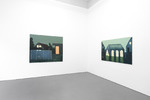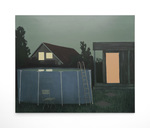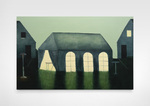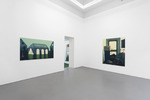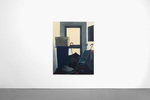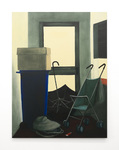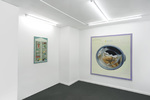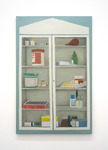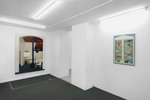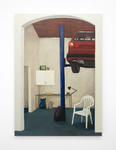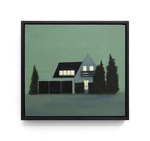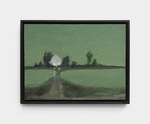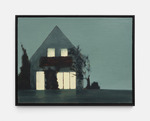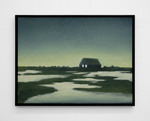SIMON MODERSOHN – VERSPROCHEN (PROMISED)
a) VERSPROCHEN / PROMISED as a verb it
expresses the making of a binding commitment,
explanation or assurance to do something
specific.
b) VERSPROCHEN /MISSPOKEN” (versprochen)
as the past participle of the German verb
“versprechen” (“to promise”, or in the
reflexive form “sich versprechen”:
“tomisspeak”), it expresses a past, completed
action, if a speaker accidentally mixed up
words, or said or expressed something other
than intended.
Simon Modersohn's paintings are mysterious, melancholic, pictorial worlds—perplexing depictions of the everyday and familiar. They are views of rural, suburban places, of interiors or still lifes.
Simon Modersohn’s landscapes are hybrid constructs. Although devoid of people, they are however, never lifeless. The images predominantly depict two-story, single family homes, most often with gabled roofs and with all of the interior lights turned on. Those completely flat, mainly rural landscapes are a reference to the northern German lowlands, and seem to be illuminated by the gentle glow of the morning dawn or evening twilight. The modernist architecture is surrounded by lawns and hedges. Here and there, various objects lie scattered on the lawn, suggesting previous activity. The manicured hedges provide privacy and also serve as fencing. They clearly separate the building from its rural surroundings and are reminiscent of enclosures that prevent unauthorized entry, exit or other disturbing influences. The owner-occupied home thus transforms into a small fortress which seals itself off from strangers as well as from the neighbors. The buildings seem to be located at the edge of town, in a new development on a previously empty field, or in settlements built outside the city limits. The distancing and isolation can be read as a symbol for the dichotomy between city and country.
The promise of a safe, idyllic sanctuary, of life in nature and still conveniently close to the city has long since disappeared, having been replaced by suburban wasteland which has become a cultural no man's land. Simon Moderson’s images bear witness to cultural and social change, to decades of transformation in rural regions. The relationship of people to their environment is one of their most essential relationships and significantly influences their lives. Just as a person is shaped by his/her surroundings, he/she in turn influences and shapes his/her environment. For centuries, life and livelihood in the countryside have been closely intertwined. For most people, the village was the center of life, the place to which he/she was personally connected, where he/she slept, ate, and worked. However, this relationship has changed significantly. Today, fewer and fewer people in the countryside still make their living from farming.
In Germany, this relationship changed dramatically from the 1950s/1960s onwards: The consolidation of agricultural land, i.e. the reallocation and reorganization of agricultural land ownership to increase efficiency, resulted in most small farmers giving up their businesses since they could not afford the expensive machines necessary for cultivating large areas. Streamlining agriculture was also devastating for nature. The consolidation of fields resulted in large-scale monocultures, causing desertification of the landscape, which in turn led to a sharp decline in biodiversity due to the clearing of hedges, destruction of field margins or the channelling of streams. The rural population now looked for work in cities. People either commuted to work or moved away entirely from the countryside; villages wasted away and became ghost towns. Thriving communities became so-called “sleeping villages” (places that are empty during the day) and “commuter towns”, and remain so to this day.
Simon Modersohn’s paintings illustrate this malaise. They are a subtle play on human presence and absence, a psychogram of current everyday life in rural and suburban areas. The buildings n Simon Modersohn’s paintings almost seem to lead a life of their own. The interiors and still lifes are also characterized by elements of the uncanny, absurd, fantastic or enigmatic.
"…." opens onto a narrow corridor that ends in a closed door. Various things are lying or standing on the floor in front of it, blocking the way to the door: a handbag out of which the red lighter must have fallen, a buggy, a dark blue garbage bin without a lid standing on a cardboard box, an open black umbrella. We're intrigued. Are we inside a house looking towards the front door, or are we outside looking in? The window with half-closed blinds behind the buggy also doesn't provide any concrete reference, except that it is brighter on the other side than where we are.
In art, a window is an ambiguous object that both separates and connects. The window frames the view from a private interior to the outdoors, it is the threshold between inside and outside. A window allows a glimpse of the past or a view of the future, or it can be a surface on which one’s inner soul is depicted.
In Simon Modersohn’s paintings, there are windows without any view whatsoever. The contact between inside and outside remains blocked. Isolated from one’s environment, only the reflection of oneself remains.
The viewer becomes a mute witness to an apparently utterly lifeless stage-set, seemingly obeying its own rules. The tension in the paintings lies in the absence of events. Our gaze is drawn to a moment of calm and stagnation, which seems unstable, threatening, and enigmatic at the same time. Simon Modersohn leads an alleged desolation of the subject into the absurd, and links the uncanny with the mysterious. The uncanny describes how the familiar becomes peculiar and strange. Our imagination is stimulated when we encounter something unfamiliar, something that we cannot classify and that at first glance seems strange to us. One tries to discover the unknown and the enigmatic, to decipher it. But not all puzzles can be solved. Some things remain unfathomable, and the explanation that exists beyond analytical thinking undoubtedly remains: we humans are probably our own biggest mystery.
*LANDSCAPE:
The character of a landscape is defined by both nature and culture. However, since the Middle Ages, the definition and interpretation of the term “landscape” have undergone a continuous and sustained shift.
“Landscape (from the Old Norse ‘landskap’) was used in the early Middle Ages to describe an interior space. It is interesting that in this usage there was no clear reference to the natural environment. Instead, the term described the qualities of residential spaces and referred more fundamentally to the social standards and conventions of the inhabitants of a particular place.”
(Olaf Kühne, Distinktion - Macht - Landschaft: Zur sozialen Definition von Landschaft, Springer Verlag, Wiesbaden 2008)
Today, landscape refers to a culturally-influenced, subjective perception of an area as an aesthetic entity, in which aesthetic, territorial, social, political, economic, geographical, organizational, ethnological and philosophical references merge.
With approximately 230 inhabitants per square kilometer, Germany is one of the most densely-populated countries in Europe. However, the population is unevenly distributed across the region.
77 percent of the people live in cities or urban centers, and only 15 percent live in villages with less than 5,000 inhabitants. The north- eastern part of Germany is particularly sparsely populated—most of the municipalities in this region have less than 50 people per square kilometer. In general, the west is more densely populated. The east of the country has been predominantly affected by an exodus due to lack of jobs, businesses, trades, medical practices and banks. Many schools and restaurants also closed. The standard of living for those who remained worsened; commutes became longer. Above all, the young, mobile, and well-educated are moving away from rural areas.
(demografie-portal.de Demographic Portal of the Federal Government)
Although the vast majority of Germans live in cities, 44 percent dream of life in the countryside. This is one of the findings of a representative study for “Die große Deutschland-Studie” by the TV channel ZDF.
Bernd Reiß
Å+ Simon Modersohn - Versprochen.pdf
PDF-Dokument [20.3 MB]

